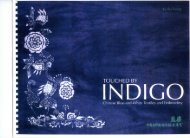Galleries at the ROM - Royal Ontario Museum
Galleries at the ROM - Royal Ontario Museum
Galleries at the ROM - Royal Ontario Museum
Create successful ePaper yourself
Turn your PDF publications into a flip-book with our unique Google optimized e-Paper software.
Four galleries devoted to Chinese art and architecture as well as galleries of Korea, Japan and <strong>the</strong> <strong>ROM</strong>’s<br />
temporary Asian exhibition space, <strong>the</strong> Herman Herzog Levy Gallery, are all loc<strong>at</strong>ed on <strong>the</strong> <strong>Museum</strong>’s main<br />
floor. These galleries are loc<strong>at</strong>ed in <strong>the</strong> Philosophers’ Walk Building on <strong>the</strong> western side of <strong>the</strong> <strong>ROM</strong>. When <strong>the</strong><br />
<strong>ROM</strong> first opened in 1914 this wing was <strong>the</strong> original <strong>Museum</strong> building. The l<strong>at</strong>er additions of <strong>the</strong> Centre Block<br />
and Queens’ Park wing were added in 1933. Over <strong>the</strong> years all of <strong>the</strong> grand windows had been lost behind<br />
partition walls th<strong>at</strong> were constructed to keep day light out. All of this was changed during Renaissance <strong>ROM</strong><br />
when this building was properly returned to its’ previous form of a grand hall with long axial views and n<strong>at</strong>ural<br />
light.<br />
Joey and Toby Tanenbaum Gallery of China<br />
Philosophers’ Walk Building<br />
This spacious gallery showcases <strong>the</strong> <strong>ROM</strong>'s outstanding Chinese<br />
collection, ranked among <strong>the</strong> world’s best outside China. Approxim<strong>at</strong>ely<br />
2,500 exceptional objects span almost 7,000 years of Chinese history,<br />
ranging from beautifully painted prehistoric ceramic jars to elabor<strong>at</strong>e<br />
18th-century AD furniture. The Joey and Toby Tanenbaum Gallery of<br />
China is divided into five <strong>the</strong>m<strong>at</strong>ic sections: The T.T. Tsui Exhibit of<br />
Prehistory and Bronze Age, tracing nearly 6,000 years of Chinese<br />
history; <strong>the</strong> Qin and Han Dynasties (221 BC - AD 220), focusing on <strong>the</strong><br />
unific<strong>at</strong>ion of China’s many independent st<strong>at</strong>es and <strong>the</strong> spread of Han<br />
culture; <strong>the</strong> Michael C.K. Lo Exhibition of North, South, Sui and Tang,<br />
Joey and Toby Tanenbaum Gallery of China<br />
exploring <strong>the</strong> political and economic divisions th<strong>at</strong> domin<strong>at</strong>ed China<br />
from <strong>the</strong> 3rd to <strong>the</strong> 6th centuries and resulted in rich cultural diversific<strong>at</strong>ion; <strong>the</strong> Song, Yuan and Frontier<br />
Dynasties (AD 907 - 1368) illustr<strong>at</strong>ing <strong>the</strong> struggles and cultural interaction between <strong>the</strong> nor<strong>the</strong>rn and sou<strong>the</strong>rn<br />
regions of China, <strong>the</strong> development of Neo-Confucian philosophy, and <strong>the</strong> growth of commerce; and <strong>the</strong> Ming<br />
and Qing Dynasties (AD 1368 - 1912), focusing on <strong>the</strong> many objects of luxury produced mainly for <strong>the</strong> court,<br />
scholars, and wealthy households of <strong>the</strong> time.<br />
The gallery is named after Joey and Toby Tanenbaum, in recognition of <strong>the</strong>ir generous gifts.<br />
Bishop White Gallery of Chinese Temple Art<br />
Philosophers’ Walk Building<br />
This inspiring gallery fe<strong>at</strong>ures one of <strong>the</strong> most important collections of<br />
Chinese temple art in <strong>the</strong> world — three of <strong>the</strong> world’s best-preserved Yuan<br />
Dynasty (AD 1271 – 1368) temple wall paintings from Shanxi Province. The<br />
Paradise of Maitreya, <strong>the</strong> largest (11.6 metres wide, 5.8 metres high; 38 ft.<br />
w., 19 ft. h.) of <strong>the</strong> three murals, depicts <strong>the</strong> Buddha of <strong>the</strong> Future<br />
enthroned in his Paradise. The mural was acquired by <strong>the</strong> <strong>ROM</strong> in 1928,<br />
and installed on <strong>the</strong> gallery’s north wall in 1933. It was cleaned and<br />
conserved from June to December 2005. The two o<strong>the</strong>r slightly smaller<br />
Daoist murals, both entitled Homage to <strong>the</strong> Highest Power, are loc<strong>at</strong>ed on<br />
<strong>the</strong> east and west walls. The gallery also houses a collection of large, richly<br />
painted wooden sculptures depicting bodhis<strong>at</strong>tvas (Buddhas-to-be and<br />
helpers of humankind) from <strong>the</strong> 12th to 15th centuries.<br />
The mural Paradise of Maitreya in <strong>the</strong> Bishop<br />
White Gallery of Chinese Temple Art<br />
The gallery is named in honour of William Charles White (1873-1960), <strong>the</strong> first Anglican Bishop from Canada to be st<strong>at</strong>ioned in<br />
Henan, China between 1909 and 1934, and subsequently <strong>the</strong> first cur<strong>at</strong>or of <strong>the</strong> <strong>ROM</strong>’s Chinese collections.<br />
<strong>Galleries</strong> of <strong>the</strong> <strong>Royal</strong> <strong>Ontario</strong> <strong>Museum</strong> Page 3 of 12<br />
2010

















